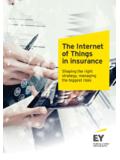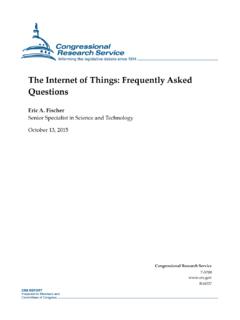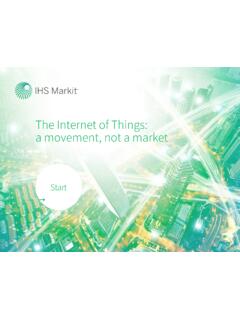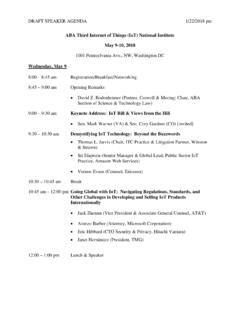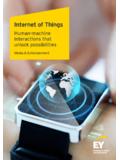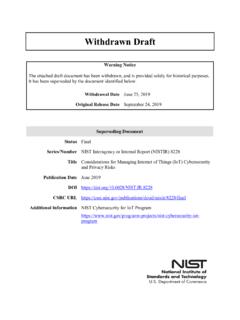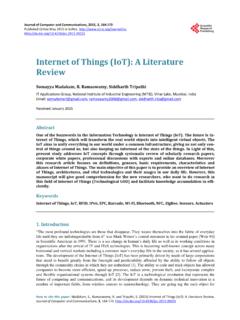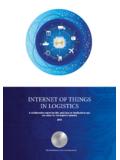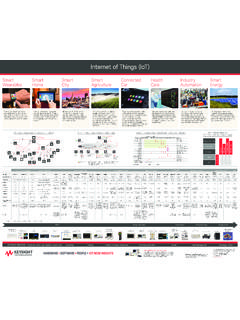Transcription of The Internet of Things Reference Model - IoTWF
1 2014 Cisco and/or its affiliates. All rights reserved. This draft document is currently Cisco Confidential Page 1 of 12 White Paper The Internet of Things Reference Model The Internet of Things (IoT) is a global industry movement that brings together people, process, data, and Things to make networked connections more relevant and valuable than ever before. Today, more than 99 percent of Things in the world are not connected. By 2020, it is estimated that billion new people and 37 billion new Things will have joined the Internet . In the near future, the growth and convergence of information, people, and Things on the Internet will create unprecedented opportunity for countries, industries, and individuals. What You Will Learn There is much discussion surrounding the IoT with multiple ways of describing it.
2 This paper provides a framework for understanding, discussing, and developing solutions for the IoT. It includes: Establishing a Reference Model for the IoT Defining standard terminology for each level Describing the functionality of, and interactions between each level The Internet of Things is Everywhere The IoT is increasing connections between people and Things and volumes of data generated on a scale that once was unimaginable. An explosion of devices and new applications combined with the reach and power of the Internet enables new types of intelligent interactions between those Things . In fact, devices already outnumber human beings on the planet by a ratio of to 1. The impact of the IoT on business spans industries and vertical markets. For example, a one percent reduction in capital expenditures from IoT-related efficiencies could save the oil and gas industry US$90 billion over 15 years (Source: GE report, Industrial Internet : Pushing the Boundaries of Minds and Machines , 2012).
3 Organizations are finding that they need to create an expanded, adaptable infrastructure that can keep pace with evolving network, compute, application, and data management demands. They must be able to address growing demand from inside and outside of their organizations. And they must be able to secure this more complex, interconnected infrastructure. DRAFT Controlled Distribution 2014 Cisco and/or its affiliates. All rights reserved. This Draft document is currently Cisco Confidential. Page 2 of 12 For providers of networking equipment and applications, the IoT potentially represents a huge market opportunity. Several trends have emerged over the past several years that are working together to shape the emerging IoT market: Rapid growth of data and analytics capabilities enabled by cloud computing Rapid growth in smart mobile devices Increasing interconnectivity between industrial, operational, and smart mobile devices Convergence of industrial and enterprise networks that enable applications such as video surveillance, smart meters, asset tracking, fleet management, digital health monitoring, and a host of other next-generation connected services Various research sources suggest the world is adopting digital infrastructure five times faster than it adopted electricity and telephony.
4 Industry estimates place the number of smart devices at 50 billion by 2020. Already today, there are approximately 46 million smart utility meters in the alone, generating billion data points ( ) every day. It is clear that the number of network connections and amount of traffic generated by the IoT will soon dwarf the number of connections and amount of traffic generated by the Internet today. As an example, for every 30 minutes of flight, the typical commercial jet airliner generates 10TB of data. With more than 25,000 flights every day, petabytes of data are being generated daily just from commercial airliners. The amount and types of traffic traversing the Internet will change in several ways: More devices attached to the Internet will operate independently of human interaction Smart devices will sometimes have limited processing capabilities, which changes interactions between the device and the network Amounts of data generated are unlike anything seen to date A New Reference Model is Needed Network, compute, application, and data management architectures that are IoT-ready require a different communication and processing Model .
5 Today, there is not a standard way of understanding or describing these models for the IoT. As a result, the lines are blurred between IoT devices and systems and non-IoT devices and systems. The fact is, not every network is an IoT network. Nor does it need to be. And not every application is an IoT application. In general, when data is generated under the control of machines or equipment and sent across a network, it is probably an IoT system. But in the IoT, even generalizations may be inappropriate. There may be many, many exceptions. This paper sets forth an IoT Reference Model . Its purpose is to provide clear definitions and descriptions that can be applied accurately to elements and functions of IoT systems and applications. This Reference Model : Simplifies: It helps break down complex systems so that each part is more understandable.
6 Clarifies: It provides additional information to precisely identify levels of the IoT and to establish common terminology. Identifies: It identifies where specific types of processing is optimized across different parts of the system. Standardizes: It provides a first step in enabling vendors to create IoT products that work with each other. Organizes: It makes the IoT real and approachable, instead of simply conceptual. 2014 Cisco and/or its affiliates. All rights reserved. This Draft document is currently Cisco Confidential. Page 3 of 12 A Comprehensive, Multilevel Model for IoT In an IoT system, data is generated by multiple kinds of devices, processed in different ways, transmitted to different locations, and acted upon by applications. The proposed IoT Reference Model is comprised of seven levels.
7 Each level is defined with terminology that can be standardized to create a globally accepted frame of Reference . The IoT Reference Model does not restrict the scope or locality of its components. For example, from a physical perspective, every element could reside in a single rack of equipment or it could be distributed across the world. The IoT Reference Model also allows the processing occurring at each level to range from trivial to complex, depending on the situation. The Model describes how tasks at each level should be handled to maintain simplicity, allow high scalability, and ensure supportability. Finally, the Model defines the functions required for an IoT system to be complete. Figure 1 illustrates the IoT Reference Model and its levels. It is important to note that in the IoT, data flows in both directions.
8 In a control pattern, control information flows from the top of the Model (level 7) to the bottom (level 1). In a monitoring pattern, the flow of information is the reverse. In most systems, the flow will be bidirectional. Figure 1. The IoT Reference Model Internet of Things Reference Model Levels Application (Reporting, Analytics, Control) Data Abstraction (Aggregation & Access) Data Accumulation (Storage) Edge (Fog) Computing (Data Element Analysis & Transformation) Connectivity (Communication & Processing Units) Physical Devices & Controllers (The Things in IoT) Collaboration & Processes (Involving People & Business Processes) 1 2 3 4 5 6 7 Sensors, Devices, Machines, Intelligent Edge Nodes of all types Center Edge Data at Rest Data in Motion Level 1: Physical Devices and Controllers The IoT Reference Model starts with Level 1: physical devices and controllers that might control multiple devices.
9 These are the Things in the IoT, and they include a wide range of endpoint devices that send and receive information. Today, the list of devices is already extensive. It will become almost unlimited as more equipment is added to the IoT over time. Devices are diverse, and there are no rules about size, location, form factor, or origin. Some devices will be the size of a silicon chip. Some will be as large as vehicles. The IoT must support the entire range. Dozens or hundreds of equipment manufacturers will produce IoT devices. To simplify compatibility and support 2014 Cisco and/or its affiliates. All rights reserved. This Draft document is currently Cisco Confidential. Page 4 of 12 manufacturability, the IoT Reference Model generally describes the level of processing needed from Level 1 devices.
10 Figure 2 describes basic capabilities for a device. Figure 2. Level 1 Physical Devices and Controllers Internet of Things Reference Model Physical Devices & Device Controllers (The Things in IoT) 1 IoT devices are capable of: ! Analog to digital conversion, as required ! Generating data ! Being queried / controlled over-the-net Sensors, Devices, Machines, Intelligent Edge Nodes of all types Edge Level 2: Connectivity Communications and connectivity are concentrated in one level Level 2. The most important function of Level 2 is reliable, timely information transmission. This includes transmissions: Between devices (Level 1) and the network Across networks (east-west) Between the network (Level 2) and low-level information processing occurring at Level 3 Traditional data communication networks have multiple functions, as evidenced by the International Organization for Standardization (ISO) 7-layer Reference Model .
